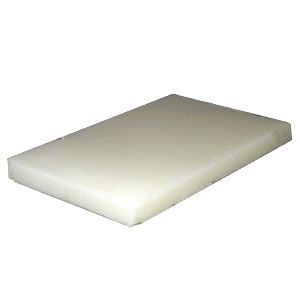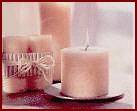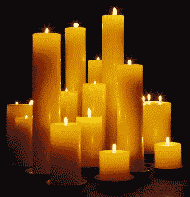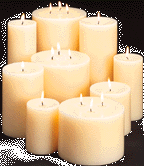

What Do You Want To Know About Candle Making?
candle making waxes
paraffin beeswax gel wax vegetable wax technical information tallow

comes in different melting points. The type of candle you are making will determine which melting point to buy. Paraffin is a petroleum by-product. It contains oil. The lower the melting temperature of the paraffin, the more oil content in the wax. You want low melt point wax for container candles, and higher melt point wax for moulded free-standing candles. Use the highest melt point wax for taper candles and hurricane candles.
container wax 55 degrees C (125-138 degrees Fahrenheit) or lower. Use when you want your poured candle to stay in its container, i.e.. glass, tin, pot etc. This wax burns the longest in the container type candles because of its higher oil content. It melts first, then burns off.
mould wax 60-62 degrees C (139-143 Fah). It has less oil in it. The free-standing candle doesn't drip as it would if the wax melted at a lower temperature. Less oil in the wax also means it is firmer and retains its moulded shape well.
dipping wax 65 degrees C (145 Fah). This is the wax you use for making taper candles. It adheres to itself, so each dip will build upon the last to form the tapered candle. This wax can also be used as an overdip for pillar candles, to help them be drip free- or to seal pressed flowers that have been glued to the pillar candle.
microcrystaline wax: Unlike paraffin waxes, microcrystaline waxes have a slightly different molecular structure. The have smaller crystals making some of them softer and more pliable. They range in color from white to brown, and in consistency from soft and sticky to hard and dry. Microcrystaline waxes come in at lest 8 forms (that I know of, there may be more). They range in melt points from 165 degrees to 240 degrees and are used for several reasons.
The sticky wax or wax glue you hear about is a micro wax.
Micro 180 seems to be the most often used one and is generally the one that is meant when people refer to micro wax.
It is a hardner and usually extend the burn time of the candles in which they are used.
Some are softeners used to make wax more workable for hand molding and some help with layer adhesion for hand dipping and over dipping.
Manufactured by Penreco (a Pennzoil & Conoco division) Wholesale only. The product is white mineral oil, gelliants, and butylated hydroxy toluene, sold as Versagel CLP, Versagel CMP and Versagel CHP. They are basically mineral oil turned to jelly.. 55 gallon minimum, shipped in a 360 pound steel drum. If this is too much, maybe they can give you dealer names They will furnish sample quarts. For retail quantities, check my links page
gel wax projectsPROJECTS area of
these pages.
Candle Cauldron has a new Gel Wax Information page which contains vast resources Gel Candle Making Wisconsin
For some great information about waxes The International Group Inc.



Natural beeswax is golden in colour, stickier and has that lovely aroma. It comes in blocks, beads or honeycomb sheets. Melt 3 parts paraffin wax and 1 part block beeswax for great container candles. I have also used this mixture for moulded candles with good success, although they don't come out of the mould as easily as straight paraffin wax candles. Experiment with your ratio of beeswax to paraffin. For candles where you tear away the mould (such as juice cans, milk cartons) you can use a high concentration of beeswax, and not worry about it releasing from the mould. Use beeswax sheets (no melting required) to roll up into candles. Beeswax has a melt point of 62 C or 146 F. This high melt point can make a pure beeswax container candle burn improperly. The candle may burn a hole straight down the wick, leaving the majority of the wax unmelted around the sides of the container. Try using a blend of low melt point (54 C or 125 F) paraffin mixed with your beeswax and increasing the diameter size of your wick instead if you have this problem. Beeswax also comes in beads. Pour the unmelted beads around a pre stiffened wick centred in a container. Tamp the beads down, then the candle is ready for burning.
Check your area for apiaries. The bee keepers often sell natural beeswax, or even coloured and scented block and sheet
beeswax. Ask if they filter it (to remove honeycomb and other material).
I recommend checking country fairs and markets, the yellow pages or your area university's agricultural extension service for
local apiaries you can call and enquire about beeswax. This will save you mailing expense for the heavy wax. You can also
buy unfiltered beeswax, melt it and pour it through nylon stockings stretched over another container to filter it yourself. One
supplier offered unfiltered beeswax for half the price of the filtered wax.
Midnite Bee Maine Beekeeping page and links to bee pages. Beeswax information : How bees make it, what it is used
for, present day and historically.... most fascinating!
Honey Bee Australis is an excellent Australian resource which includes a chat room, library and honey recipes.
vegetable waxes
soy wax
Wax made from hydrogenated soybean oil, generally results in a one-pour effect. That is it doesn't shrink when it cools after
pouring, and no repouring is required to fill the shrink hole. It also adheres well to containers, such as glass. So you don't get
the air bubbles also known as 'wet spots' that can happen with paraffin not properly handled. Pigment dyes do not dissolve
in soy wax, so its best to use powder or liquid dyes. Larger diameter wicks are often required. Check with your supplier of
soy wax to see what works best with regard to wicks, colours and scents. I have not researched the claimed health benefits
of soy wax versus paraffin wax, and have I not tested the claims about less soot.
carnuba wax
from Koster Keunen
Vegetable wax exuded by the leaves of the Brazilian Carnauba Palm.
ceresine
from Koster Keunen Ceresine was originally derived from the refining and bleaching of mineral waxes. Today's Ceresine
containes 55 to 90% paraffin waxes, the remainder being micos and other compounds compatible with the original blend.
Properties will vary.
Koster Keunen takes a palm oil and a coconut waste product and modify them with certain
other vegetable waxes to produce a wax which is all natural, much less expensive than beeswax and has a burn quality higher
than paraffin.
bayberry
One pound of wax can be made from boiling 4 pounds of berries, and skimming the wax off the top. The melt point of
bayberry wax is 47 to 49 C. (116.6 to 120.2 F.) For more on bayberries, please visit Mrs. Greve's A Modern Herbal . .
At the National Candle Association (USA)there is a paper available for purchase called
Candle Colorants for Natural/Vegetable Waxes Author: Peter French, French Color & Fragrance Company, Inc.
Presented April 2002 A presentation of the differences in color using the same colorant in finished candles in six different
wax raw materials (5 natural/vegetable and 1 paraffin). Information is also presented about how fragrance may affect the
colors in finished candles.
more technical information
At the National Candle Association (USA) there are technical papers available for purchase, titles below:
Beeswax and Other Non-Paraffin Waxes
The Chemistry of Vegetable Waxes and Its Applications for Candles
Natural and Vegetable Waxes: An Overview
The Use of Partially Hydrogenated Vegetable Oil as a Paraffin Replacement in Candle Formulation and Production
Paraffin Waxes: Structure, Characteristics and Properties
Wax Crystal Morphology and Molded Candles
Natural & Vegetable Waxes: Some Comments
Microcrystalline Waxes, Structure, Property and Uses
Petroleum Waxes for the Candle Industry
Natural and Vegetable Waxes and How They Burn
Bleeding (Syneresis) in Candles from a Wax Perspective
Natural Waxes
Paraffin Waxes -- The Use of Mass Spectroscopy and GC [gas cromatography]
New Advances in Gas Chromatography
Paraffin Waxes: Natural Products Sourced from Petroleum A detailed presentation on paraffin waxes, including general
information on the types of waxes and their sources, a comparison of the chemical structure of paraffin vs. vegetable waxes
and how the chemical structure affects the properties of paraffin waxes. Wax manufacturing steps are also reviewed. Finally,
several key properties are reviewed as to how they relate to candles.
Here is a recipe you may find interesting. Its from the Country Woman's Association Cookbook (1956 edition) Its an
Australian book of recipes and home keeping hints. "To 15 lbs of Mutton tallow (fat) add 1.25 lbs beeswax. Cut up wax
and place with fat into water. Boil 1 hour in large saucepan. Allow it to get cold then cut out the cake of fat and scrape off
the soft under part. Now make a weak lye of either ashes or soda. Cut up your fat and put it into this, and add to it .5 lb
each of alum and saltpetre. Skim carefully while it is simmering. When cold, take it out of the water. It is now ready to be
rendered down and poured into the candle moulds." I have never tried this myself, I find paraffin and beeswax much more
convenient!
What Do You Want To Know About Candle Making?